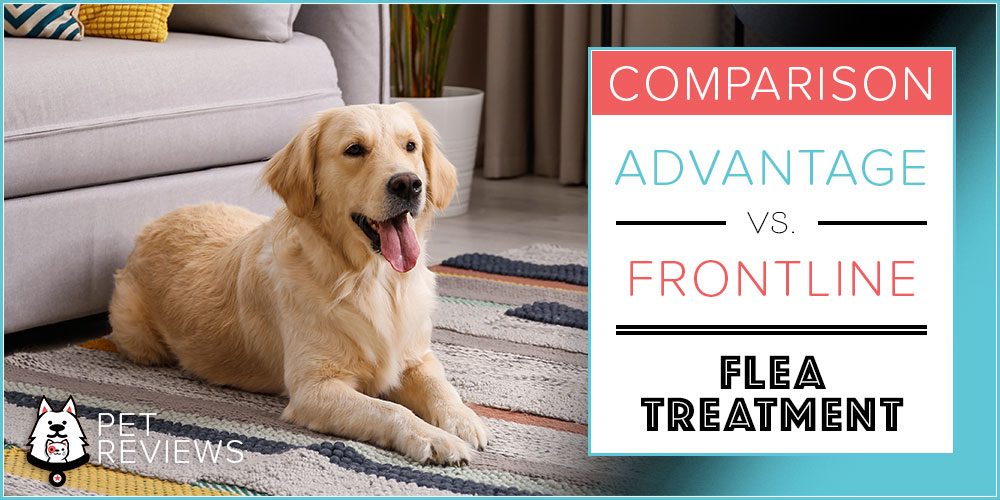Advantage vs. Frontline: 2024 Comparison and Key Differences
Quick Guide
When beginning the search for a flea treatment, the most crucial consideration is the particular pet and their specific needs. For example, if a dog is already taking medication, the type of flea treatment that is safe for them to use will be limited. A pet’s allergies or reactions to products will also affect which treatment is ultimately the best one.
Luckily, there are many different types of products on the market to fit all kinds of needs and preferences. Flavored chews are excellent for their convenience, whereas topical solutions usually provide a broader spectrum of coverage against multiple pests. Flea collars offer long-term coverage and are easy to use.
Choosing a product may seem intimidating at first, but when you keep your specific pup in mind and consider a few critical factors, finding the most effective and safest option for your pet will be easy.
What to Look for in a Good Flea Treatment
The best flea treatments will share some of the same attributes. They will use safe and effective ingredients, provide protection against multiple pests, and maintain their efficacy for the full duration of the treatment. Most importantly, they will also work wonderfully for the individual needs of your particular pup.
Every flea prevention product uses a separate active ingredient depending on how the treatment is administered. For example, oral medications will require different ingredients than a topical solution to work properly. Since the method of delivery is different, oral versus topical, the ingredient will need to be different, too.
Another vital consideration is the number and type of pest covered by the treatment. A few products defend against fleas only, while many others will protect against ticks, mosquitoes, biting flies, and lice. For most environments, it is wise to select a treatment that guards against at least fleas and ticks.
To ensure that your pet is adequately shielded from pests, check the duration of the treatment, as it will vary from product to product. The majority of treatments need to be given every 30 days; however, a few other products last for 12 weeks or even eight months. Remember that flea treatment should be administered year-round to prevent infestations.
Advantage and Frontline Similarities
Advantage and Frontline, despite their differences, are very similar products effective in preventing and killing fleas and recommended by veterinarians.
The most apparent similarity between these two products is their form, as they are both topical solutions. Advantage and Frontline need to be applied directly to a dog’s skin, not on the fur so that it can work correctly and distribute evenly.
Advantage and Frontline work on contact, which means a flea does not have to bite your dog for the treatment to work. In this way, these products help prevent the irritation and scratching that accompany flea bites.
Both Advantage and Frontline are monthly treatments that must be applied every 30 days. To maintain full protection, make sure to apply every dose on time throughout the year. If you miss a dose, simply apply the product when you remember and then continue treating every 30 days from there.
If you are bathing your dog before applying either Advantage or Frontline, make sure they are completely dry before administering the treatment. Also, if your pup loves to swim, Advantage and Frontline are waterproof, but it is best to wait 24 hours after treatment before allowing swimming.
With any topical solution, including Advantage and Frontline, frequent bathing or swimming may result in the product losing efficacy for the full 30 days.
Neither Advantage or Frontline is a prescription medication, which means a prescription from your vet is not required to purchase them. They are available over-the-counter at a veterinary office or even at some pet stores and online retailers.
Both Advantage and Frontline are excellent products to treat flea infestations because they are effective in killing fleas in all life stages. Only about 5% of an infestation is adult fleas, while the other 95% is fleas in immature stages invisible to the human eye. These two products eradicate infestations because they kill flea eggs and larvae, as well as adults.
Advantage and Frontline Differences
Advantage and Frontline share many similarities, yet they distinguish themselves in several ways, especially in the types of pests they work against.
Advantage prevents and kills fleas in all stages of life, including eggs and larvae. It is also able to treat, prevent, and control lice infestations. Although Frontline also kills fleas, flea eggs, flea larvae, and chewing lice, it kills ticks, too. Ticks transmit Lyme disease, so Frontline’s ability to defend against ticks helps protect your dog from a serious illness.
Frontline uses a triple-action formula to guard against pests, whereas Advantage utilizes a combination of two ingredients. Even though one ingredient, pyriproxyfen, is common to both products, Advantage includes imidacloprid, as well. Frontline, however, has fipronil and (S)-methoprene that fight against fleas and ticks.
Advantage and Frontline both begin working quickly, but the timing is a bit different. Frontline starts killing fleas 30 minutes after applying, achieving full efficacy within 12 hours. On the other hand, Advantage kills fleas within 12 hours of application.
Advantage and Frontline Pricing Comparison
Advantage is offered in four sizes based on the pet’s weight and is sold in packs of either four or six treatments. The price remains the same no matter the weight range, though the six-dose box is more expensive than the four-dose box. Per treatment, the pack of six doses is more economical even though it is more costly upfront.
- Advantage 3-10 lbs. $43.98 (4) or $58.98 (6)
- Advantage 11-20 lbs. $43.98 (4) or $58.98 (6)
- Advantage 21-55 lbs. $43.98 (4) or $58.98 (6)
- Advantage over 55 lbs. $43.98 (4) or $58.98 (6)
Likewise, Frontline is sold in four sizes, depending on the dog’s weight. It comes in boxes of either three or six doses, and the price is the same for all weight ranges. The six-dose pack is more costly than the three-dose pack. Even though it is more expensive upfront, the six-treatment box is less expensive per dose.
- Frontline 5-22 lbs. $45.99 (3) or $80.99 (6)
- Frontline 23-44 lbs. $45.99 (3) or $80.99 (6)
- Frontline 45-88 lbs. $45.99 (3) or $80.99 (6)
- Frontline 89-132 lbs. $45.99 (3) or $80.99 (6)
Of these two products, Advantage is more economical. The four-dose pack of Advantage is less expensive than the three-dose box of Frontline, and the six-dose box of Advantage is less costly than the same quantity of Frontline. Per treatment, Advantage is approximately four dollars less than Frontline, making it a more cost-effective option.
Our Review of Advantage and Frontline
Advantage, a topical solution, provides excellent protection at an affordable price. Because Advantage is a bit milder than other flea treatments, it works well for geriatric pets. Applied every 30 days, Advantage is an effective choice when combatting flea infestations since it kills fleas in all stages of life.
Frontline is also a topical treatment that repels and kills fleas. Additionally, it kills ticks that may transmit Lyme disease. A fast-acting product, Frontline begins killing fleas 30 minutes after application but needs to be administered every 30 days to maintain its full efficacy. Although it is more expensive than Advantage, Frontline is still a cost-effective product.
Advantage and Frontline are both routinely recommended by veterinarians. However, Advantage is the more effective product in treating and killing fleas. Even though it does not protect against ticks like Frontline, Advantage receives much better consumer reviews in terms of how well it works.
Many customers complain about Frontline’s failure to actually kill fleas, which reflects in its less than stellar 3.5-star consumer ratings.
Advantage, though, consistently earns 4.5-star ratings from customers celebrating its ability to kill fleas and treat infestations. Since Advantage and Frontline are very similar products otherwise, the difference in their effectiveness is crucial, making Advantage the superior product.
Flea Treatment FAQs
How Do You Apply a Topical Solution Correctly?
Proper application is essential to ensure that a topical solution works correctly. Topical treatments must be applied directly to the dog’s skin, not on the fur. To do this, part the fur between the shoulder blades and apply some of the product to the skin. Then, repeat by parting the fur and applying a few more times down the pet’s back for even distribution.
Be careful not to apply the product too close to the tail where your pet can turn and lick it off. If you are worried about applying the treatment correctly, every product comes with instructions that you can follow to learn about proper application. You can also seek assistance from your veterinarian who will be able to help with proper application.
What Are the Dangers of Flea Infestations?
You might think fleas are only a nuisance, irksome and irritating, but generally harmless. Unfortunately, fleas can have more serious implications for your pup’s health.
First, flea bites are annoying and itchy, causing skin irritation. Some pets can even be allergic to flea bites, which results in skin infections that range from minor to severe.
Tapeworms, an intestinal parasite, are another issue associated with fleas. Dogs can contract tapeworms, which require worming medication to treat, from ingesting fleas.
A flea infestation can also cause anemia. Fleas feed on a pet’s blood, and in the case of outbreaks, excessive flea biting may result in anemia or decreased red blood cell count. Anemia might make a pet feel tired or weak and is more common in small or young pets that are suffering from a severe flea infestation.
Can You Touch Your Dog After Applying a Topical Treatment?
Most topical flea treatments are considered insecticides, and you should avoid touching the area where the treatment was applied until it is completely dry. The same is true for children, who should also not have contact with the treated area until it dries entirely.
If you have multiple pets, make sure they do not groom each other after you apply the product. You may need to keep pets separate until the treatment dries to ensure another pet does not ingest any product by grooming furry friends.
Conclusion
Advantage and Frontline are incredibly similar products that repel and kill fleas in all life stages, including eggs and larvae. Both are topical treatments that require administration every 30 days to maintain effectiveness.
Advantage is excellent in killing fleas and controlling flea infestations. With exceptional customer reviews and vet recommendations, Advantage offers excellent efficacy at an affordable price. In fact, it is one of the most economical flea treatments on the market. No veterinary prescription is needed to purchase Advantage as it is available over-the-counter.
Frontline, another over-the-counter flea treatment, also comes at a reasonable price. Although it is more expensive than Advantage, it remains a cost-effective product compared to other treatments. In addition to fleas, Frontline provides protection against ticks, which can help keep your pet safe from Lyme disease.
Even though Advantage does not include any defense against ticks, it is more effective in repelling and killing fleas than Frontline. Many consumers complain that Frontline is not successful in killing fleas and treating infestations. These customers report that fleas remained even after multiple monthly applications of Frontline.
Advantage, however, consistently earns high ratings from customers who are pleased with its formidable ability to kill fleas and control infestations. As monthly topicals, Advantage and Frontline are already quite similar, so their effectiveness is of the utmost importance when determining which product is preferred.
Due to its superior efficacy, its more affordable price, and its outstanding customer and veterinarian recommendations, Advantage is the better choice between these two products when considering a flea treatment.
As with any medication or product, always consult with your veterinarian before applying a treatment. After all, safety is the most important characteristic of a flea treatment, and your vet can help you decide which flea product is the safest and most effective for your particular dog.










